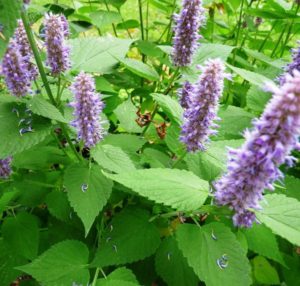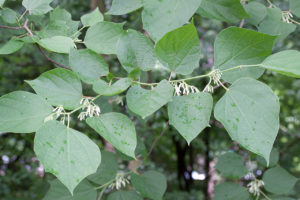By - April 18, 2022
Categories: General
Today we’re going to be continuing our series on herbalism in Traditional Chinese Medicine! Now, if you missed my blog post “Intro to Herbal Medicine,” you might want to start there. But we’ll review here quickly as well.
In TCM, herbal medicine is used to restore balance to the body and improve the flow of qi. We use over 400 plants, minerals and/or animal products separately or in various combinations to treat different conditions of the body.
At Altitude Acupuncture, we prefer to administer herbal remedies in pill form. We use Golden Flower Chinese Herbs because they are free of soy, wheat, dairy, corn, yeast, and animal products.
In Traditional Chinese Medicine, there are 50 fundamental herbs. We discussed the first 5 (astragalus, dong quai, ginger, kudzu, and licorice) in the last herbal medicine post. In this post we’ll be looking at Korean Mint, Chinese Alangium Root, Chinese Anemone, Mountain Henbane, and Marlberry.
Korean Mint (Agastache rugosa, huòxiāng 藿香)

Part used in TCM: Leaves, seeds
Energetics and Taste: Warming, dry
Organs affected: Spleen, stomach, lung
Uses: Korean Mint transforms dampness that is obstructing the stomach and spleen. Traditionally it’s used to relieve nausea, vomiting, and poor appetite. It can also be used to treat morning sickness! While its primary uses are for stomach ailments (including infections), it’s also been used to treat anxiety.
Warnings: Agastache rugosa is considered safe when used in recommended doses, but there is a possibility of allergic reactions if you have any allergic reactions to the hyssop plant or or any hyssop containing products.
Chinese Alangium Root (Alangium chinense, bā jiǎo fēng 八角枫 )

Part used in TCM: Root
Energetics and Taste: Pungent, bitter, slightly warm, slightly toxic
Organs affected: Liver, heart, kidneys
Uses: In TCM, Chinese alangium root dispels wind, eliminates dampness, relaxes the tendons and bones, dissipates stasis, and alleviates pain. Realistically what this means is that it helps with things like rheumatoid arthritis, numbness, traumatic injuries, wounds, and has even been used for snakebites.
Warnings: Do not use during pregnancy or with children. Can be poisonous if used incorrectly.
Chinese Anemone (Pulsatilla chinensis, bái tóu weng 白头翁)

Part used in TCM: Whole above ground herb, root
Energetics and Taste: Bitter, cold
Organs affected: Stomach, liver, large intestine
Uses: Because of its cold and bitter energetics, anemone is used to clear heat and eliminate toxins. It’s been used to treat things like nosebleeds, internal hemorrhoids with bleeding, unpleasant vaginal discharge, swelling sores, and parasites in the stomach or intestines. In addition, Chinese anemone is known to calm the nerves, and can be used to treat anxiety and mild depression.
Warnings: This is a low dose herb. Overdose can lower the heart rate and cause mental confusion.

Mountain Henbane (Anisodus tanguticus, shān làngdàng 山莨菪)
Part used in TCM: root
Energetics and Taste: Pungent, bitter, warming
Organs affected: Nervous system
Uses: If mountain henbane sounds like a poison, that’s probably because it’s part of the nightshade family (don’t worry, so are tomatoes, eggplant, and bell peppers). But in Traditional Chinese Medicine, it’s been used for thousands of years to treat shock and vasospasms, meaning this herb could save your life.
Marlberry (Ardisia japonica, zǐjīn niú 紫金牛)

Part used in TCM: Leaves
Energetics and Taste: Bitter, pungent, slightly cold
Organs affected: Lung and liver
Uses: Marlberry is very good at relieving coughs and resolving phlegm due to heat. Because of its actions of clearing heat, it can also alleviate swelling, and has been used (often in combination with other herbs) to treat jaundice. Because Marlberry is also good at activating blood and resolving stasis, it’s widely used to alleviate things like bruising and menstrual issues.
Warnings: Large doses can be toxic to the kidneys.
Like everything in Traditional Chinese Medicine (or Western medicine, for that matter), it’s important to talk to a professional before starting on a new herbal regiment. There are a ton of factors that contribute to any symptoms you may be experiencing, and there are a ton of considerations as to which herbal supplements will be best to treat the underlying cause of the symptoms, as well as the symptoms themselves. And I’ve found that herbal medicine often works best when paired with other herbs and/or treatments. Traditional Chinese Medicine is about restoring balance to the body, so we don’t want to go overboard in any one treatment.
Be well.
This information is for educational purposes only and is not intended to diagnose, treat or cure any disease or illness. Please consult your healthcare provider prior to the use of this product if you are pregnant, nursing, taking medications or have a medical condition. Individual results may vary.
